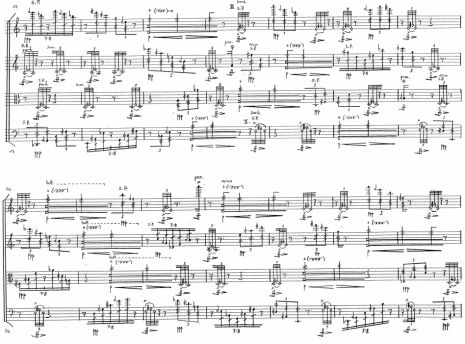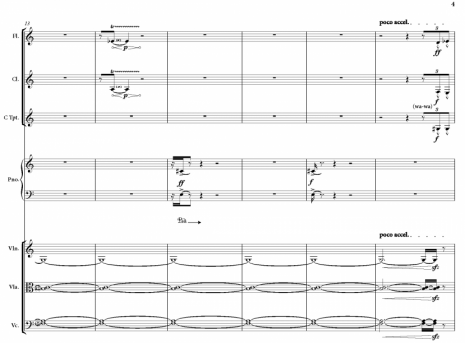Concepts in Practice
It’s complicated. It’s actually very complicated.
When you mention repetition as a ‘false friend’ in my music you are spot-on correct. My music is not typically about creating stable, hypnotic states, but rather, to a large extent, it is about creating a sense of fleeting stability, and about generating unpredictability and surprise. It is also about revealing the complexities of how we identify, order and classify things and the myriad ways we connect and disconnect parts and sums.
I love the idea of repetition because it is a concept that at first seems so obvious, and yet, when considering the idea at length, it becomes much more difficult to pin down. It is really quite paradoxical, because it is impossible to actually repeat any event identically. Events may be simulated, but there really is no pure repetition. There are perhaps infinite degrees of difference—some very subtle, some very stark, and everything in between. But what then is a difference? Can something be totally or purely different from something else? I don’t think so, as some aspect of similarity can always be established.
The idea of repetition is a complex, connective form of being analogous while the idea of difference is a form of not being analogous (being other), which plays against the expectancy and identity presented by repetition. However, one cannot exist without the other. Difference and repetition feed into and off of one another. Complex differences hide in simple repetitions. Complex repetitions linger in various states of difference. Gilles Deleuze’s book, “Difference and Repetition,” has had a big influence on my work. Click here to view excerpt.
I think of repetition as a tool that functions to establish identity (of a structure, of a timbre, of a form). It establishes boundaries around something, allowing parts to be more clearly discerned from an otherwise more undifferentiated whole. These boundaries create expectations—of continuation, of change, (it depends on the context), and expectations are crucial to creating a feeling of contrast (of difference). On one hand, I use repetition to reveal subtle differences that linger in what might be, at first, thought of as identical. On the other hand, I use it to create stark contrasts that might have been only vaguely perceived otherwise.
Repetition amplifies, sharpens and clarifies the perception of difference. Most obvious to me - and I am astonished has not been more widely practiced - is that to generate surprise, you must first establish predictability.
The title, Color, Form, Line, is a reference to the work by the visual artist Ellsworth Kelly, Line Form Color. In Kelly’s work - actually, a book he made - a succession of images proceeds from one to many lines, then to primary color fields, then mixed color fields, and finally shapes embedded in color. My own work follows roughly the same strategy in multiple, reversed orders, and emphasizes, like the Kelly, the futility of fully separating the experience of color from that of shape/gesture and how the order, or ‘form’ of these successions either intensifies or dilutes the perception of each.
More specifically, ‘Color’ refers to the individual quality of a sound, but more commonly, the quality of sounds in combination (mixed sounds). ‘Form’ refers to the overall order of the work—how events pass from one to the next. ‘Line’ refers to how the listener makes connections from sound to sound (i.e. melody), but also to how connections are made across the entire form of the work. For example, in a novel or play, there might be multiple plot lines that do not simply run their course at once, linearly, but which alternate with one another throughout the course of the work. While the overall ‘Form’ of the work might be A-B-C-D-B-A-A-D-C, four different ‘Lines’ can be traced through the form, each identifiable by specific instrumental ‘Color.’
Also:



